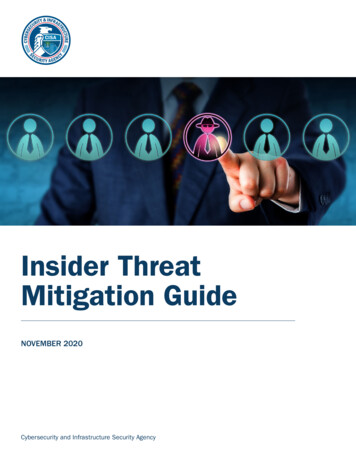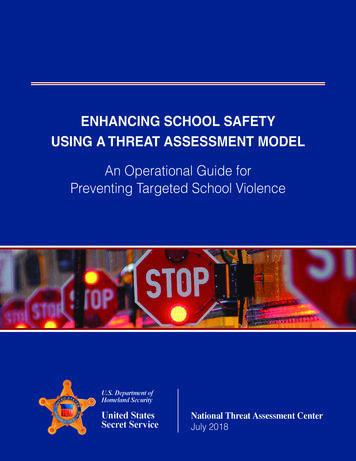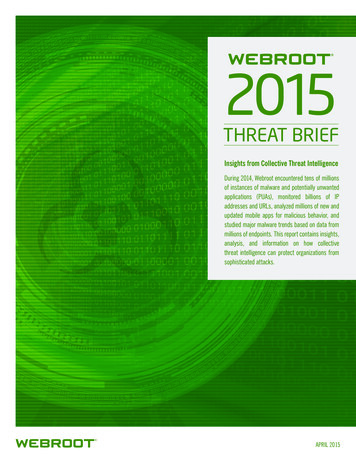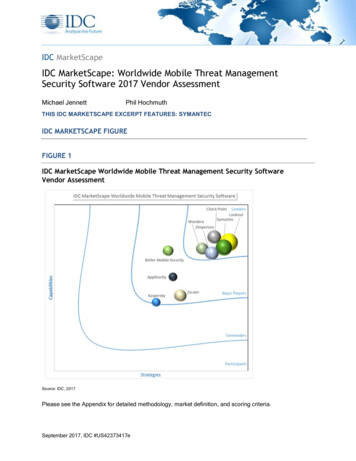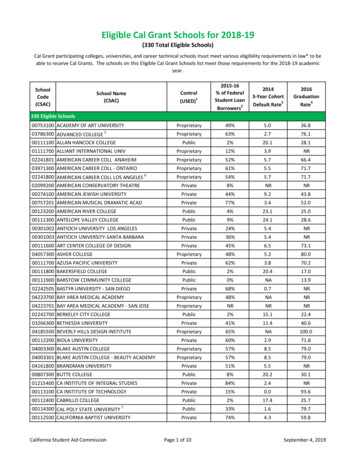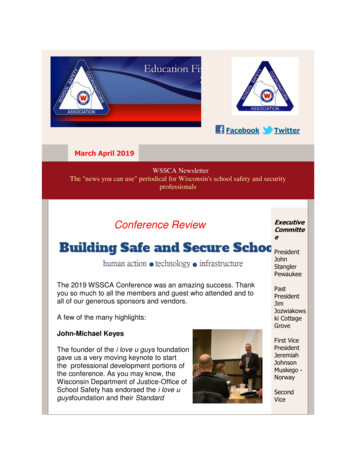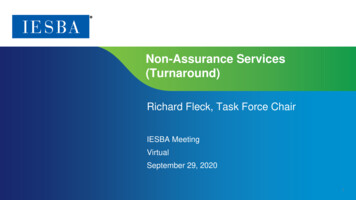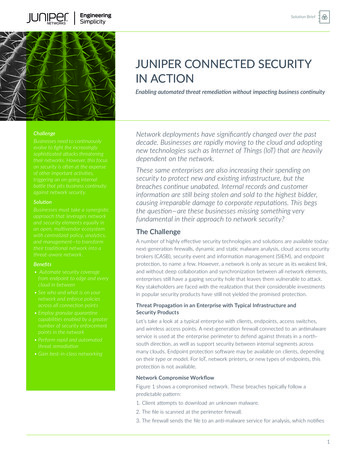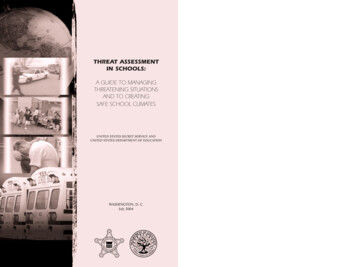
Transcription
THREAT ASSESSMENTIN SCHOOLS:A GUIDE TO MANAGINGTHREATENING SITUATIONSAND TO CREATINGSAFE SCHOOL CLIMATESUNITED STATES SECRET SERVICE ANDUNITED STATES DEPARTMENT OF EDUCATIONWASHINGTON, D. C.July 2004
THREAT ASSESSMENT IN SCHOOLS:A GUIDE TO MANAGING THREATENING SITUATIONSAND TO CREATING SAFE SCHOOL CLIMATESUNITED STATES SECRET SERVICEANDUNITED STATES DEPARTMENT OF EDUCATIONbyRobert A. Fein, Ph.D.DirectorNational Violence Prevention and Study CenterBryan VossekuilDirectorNational Violence Prevention and Study CenterWilliam S. Pollack, Ph.D.Director, National Violence Prevention and Study CenterAssistant Clinical ProfessorHarvard Medical School / McLean HospitalRandy Borum, Psy.D.Associate ProfessorUniversity of South FloridaWilliam ModzeleskiAssociate Deputy Under SecretaryOffice of Safe and Drug-Free SchoolsU. S. Department of EducationMarisa Reddy, Ph.D.Chief Research Psychologist and Research CoordinatorNational Threat Assessment CenterU. S. Secret ServiceWashington, D. C.July 2004i
THREAT ASSESSMENT IN SCHOOLS GUIDEDisclaimerThe findings, conclusions, andopinions expressed in this documentare those of the authors, and do notnecessarily reflect the officialposition or policies of the U.S.Department of Education or theU.S. Department of the Treasury.PREFACEJoint message from the Secretary, U.S. Department of Education, and from theDirector, U.S. Secret ServiceSince June 1999, the U.S. Department of Education and the U.S. Secret Service havebeen working as a team to try to better understand–and ultimately helpprevent–school shootings in America. When we began this collaboration nearlythree years ago, we did not know what information we might uncover in the courseof our joint study on targeted violence in schools, known as the Safe School Initiative.However, throughout our collaboration, our two agencies have focused on onecommon goal: to develop accurate and useful information about prior school attacksthat could help prevent some future ones from occurring.We believe the results of this effort have given schools and communities real causefor hope. Through the Safe School Initiative, staff from the U.S. Department ofEducation’s Safe and Drug-Free Schools Program and the U.S. Secret Service’sNational Threat Assessment Center have found that some school attacks may bepreventable. The companion report to this document, The Final Report and Findingsof the Safe School Initiative: Implications for the Prevention of School Attacks in theUnited States, details findings from the Safe School Initiative and includes several keyfindings relevant to prevention efforts. In particular, the Safe School Initiativefindings indicate that incidents of targeted violence in school were rarely impulsive;that the students who perpetrated these attacks usually planned out the attack inadvance–with planning behavior that was oftentimes observable; and that, prior tomost attacks, other children knew that the attack was to occur. Taken together, thesefindings suggest that it may be possible to prevent some future school attacks fromoccurring–and that efforts to identify, assess, and manage students who may have theintent and capacity to launch an attack may be a promising strategy for prevention.This document, Threat Assessment in Schools: A Guide to Managing ThreateningSituations and to Creating Safe School Climates, takes these findings one step furtherby setting forth a process for identifying, assessing, and managing students who maypose a threat of targeted violence in schools. This process–known as threatassessment–was first pioneered by the U.S. Secret Service as a mechanism forinvestigating threats against the president of the United States and other protectedofficials. The Secret Service threat assessment approach was developed based uponfindings from an earlier Secret Service study on assassinations and attacks of publicofficials and public figures.This Guide represents a modification of the Secret Service threat assessment process,based upon findings from the Safe School Initiative. It is intended for use by schoolpersonnel, law enforcement officials, and others with protective responsibilities inour nation’s schools. This Guide includes suggestions for developing a threatassessment team within a school or school district, steps to take when a threat oriiiii
THREAT ASSESSMENT IN SCHOOLS GUIDEACKNOWLEDGMENTSother information of concern comes to light, consideration about when to involve lawenforcement personnel, issues of information sharing, and ideas for creating safeschool climates.We applaud all of you working to keep children safe in school. We hope that theinformation in this Guide, and the companion Final Report, assist you in yourcontinued efforts to do so.Rod PaigeSecretaryU.S. Department of EducationMay 2002W. Ralph BashamDirectorUnited States Secret ServiceACKNOWLEDGMENTSThe authors of this Guide are grateful to many agencies and individuals for theirassistance in planning and carrying out the Safe School Initiative and for assistance inthe development and writing of this Guide. First and foremost, the authors owe adebt of gratitude to the representatives of the numerous law enforcement andcriminal justice agencies that permitted Secret Service personnel to reviewinvestigative files on the school attacks in their respective communities; providedother key information and materials about these attacks; and assisted and supportedSecret Service personnel in seeking permission to interview 10 attackers. Moreover,the authors are grateful to the U.S. Department of Justice, Office of JusticePrograms’ National Institute of Justice for providing critical financial support thathelped make the study possible.This Guide would not have been possible without the support and assistance that theauthors received from several key officials and personnel at the Department ofEducation and the Secret Service. Absent the significant contributions of theseindividuals, the Secret Service’s experience in researching and preventing targetedviolence could not have been translated into a useful guide about threat assessmentand targeted school violence. At the Department of Education, these individuals are:Secretary of Education Rod Paige, Assistant Secretary for Office of Elementary andSecondary Education Susan B. Neuman, and Connie Deshpande. Secret Serviceofficials who provided guidance and support for this project include: Director BrianStafford, Special Agent in Charge George Luczko, Assistant Special Agent in ChargeMatt Doherty, Assistant to the Special Agent in Charge Cindy Rubendall, andResident Agent in Charge John Berglund.The authors extend special thanks to Assistant Director Barbara Riggs, Office ofProtective Research, U.S. Secret Service for her support of the Safe School Initiativeand the National Threat Assessment Center.The Guide benefited from the thoughtful comments of a focus group of educationand law enforcement leaders that was organized by the Department of Education.Participants in the group included: Ahndrea Blue, James Campain, MarilynCopeland, Melissa DeRosier, Steve Edwards, David Friedberg, Jeff Heller, LizKarnes, James Kelly, Wesley Mitchell, Lawrence Porte, Frank Sanchez, Jr., KateStetzner, Melorra Sochet, Betsy Thompson, and John Van Dreal.Finally, the authors acknowledge the contributions of Mary Rowe, Paul Gebicke,Gwen Holden and several anonymous reviewers from the Department of Education,whose observations and comments helped to shape the Guide. Special thanks go outto Gwen Holden and Paul Kelly, who helped edit the Guide.ivRobert FeinBryan VossekuilWilliam PollackRandy BorumWilliam ModzeleskiMarisa ReddyWashington, D.C.May 2002v
THREAT ASSESSMENT IN SCHOOLS GUIDETABLE OF CONTENTSChapter I:Introduction: Threat Assessment and thePrevention of Targeted School Violence . . . . . . . . . . . . . . . . . . . . .1Chapter II:Creating Climates of School Safety:A Foundation for Reducing School Violence . . . . . . . . . . . . . . . . . .9Chapter III:Key Findings of the Safe School Initiative’sStudy of Targeted School Violence . . . . . . . . . . . . . . . . . . . . . . . . .15Chapter IV:Implementing a School Threat Assessment Process . . . . . . . . . . .27Chapter V:Conducting a School Threat Assessment . . . . . . . . . . . . . . . . . . . .41Chapter VI:Managing a Threatening Situation . . . . . . . . . . . . . . . . . . . . . . . . .61Chapter VII:Action Plans for School Leaders:Creating a Safe and Connected School Climate andImplementing a Threat Assessment Program . . . . . . . . . . . . . . . . .67Chapter VIII:Conclusion: Threat Assessment as aDecision-Making Tool . . . . . . . . . . . . . . . . . . . . . . . . . . . . . . . . . . .75Appendix:Annotated Resources . . . . . . . . . . . . . . . . . . . . . . . . . . . . . . . . . . .79Author Brief Bios . . . . . . . . . . . . . . . . . . . . . . . . . . . . . . . . . . . . . .87vivii
THREAT ASSESSMENT IN SCHOOLS GUIDEviii
CHAPTER I - INTRODUCTIONCHAPTER IINTRODUCTION:THREAT ASSESSMENTAND THE PREVENTIONOF TARGETED SCHOOLVIOLENCE
CHAPTER I - INTRODUCTIONThe vast majority of the nation’s students will complete their schooling without everbeing touched by peer violence. Nevertheless, recent school attacks carried out bystudents have shaken the image of schools as reliably safe and secure environmentsin which the qualifications of teachers and the efficacy of the educational curriculaare the most pressing concerns of educators and parents. Televised images offrightened and injured students fleeing school grounds have imprinted themselves onthe American consciousness. "Columbine," the Littleton, Colo. high school that onApril 20, 1999, was the scene of the most violent of the school attacks recorded todate in the United States, has entered contemporary vocabulary as a national symbolof the violence that claimed the lives of 14 students and a teacher on that day.Incidents of targeted school violence1 occurred in 37 communities across the countrybetween December 1974 and May 2000. Compared to the other types of violenceand crime children face both in and outside of school, school-based attacks are rare.While the Department of Education reports that 60 million children attend thenation’s 119,000 schools, available statistics indicate that few of these students willfall prey to serious violence in school settings.2However, highly publicized school shootings have created uncertainty about thesafety and security of this country’s schools and generated fear that an attack mightoccur in any school, in any community. Increased national attention to the problemof school violence has prompted educators, law enforcement officials, mental healthprofessionals, and parents to press for answers to two central questions: "Could wehave known that these attacks were being planned?" and, if so, "What could we havedone to prevent these attacks from occurring?"For example, what should happen when a student comes to attention for sayingsomething or behaving in a manner that causes concern, as in the followinginstances? "The kids are saying that Johnny told his friends not to go to the cafeteria atnoon on Tuesday because something big and bad is going to happen." Marty, who has appeared withdrawn and irritable the past few weeks, handedin a story about a student putting a bomb in an empty school. Sandy brought bullets to school to show friends. Rafael, who got pushed around again after gym class, stormed out in tears,shouting "You’re all going to pay!"1“Targeted violence” is defined as any incident of violence where a known or knowable attacker selects aparticular target prior to their violent attack. See Fein, R.A., Vossekuil, B. & Holden, G. "Threat Assessment:An Approach to Prevent Targeted Violence." Research in Action. U.S. Department of Justice, Office ofJustice Programs, National Institute of Justice: Washington, D.C. (September, 1995), at 1-7. NCJ 1550002U.S. Department of Education. National Center for Education Statistics (2000). Digest of EducationStatistics 2000. Washington, D.C.: Authors3
THREAT ASSESSMENT IN SCHOOLS GUIDE Casey, who was suspended last year for bringing a knife to school, left a "hitlist" on his desk. Terry submitted an essay in which an assassin blew up the school, attacked thegovernor, and then killed himself.Given the enormous concern about targeted school violence, these reportedstatements and behaviors cannot be ignored. But how should school officials andother responsible adults respond?This publication, Threat Assessment in Schools: A Guide to Managing ThreateningSituations and to Creating Safe School Climates, is the product of an ongoingcollaboration between the U. S. Secret Service and the U. S. Department ofEducation to begin to answer these questions. Its focus is on the use of the threatassessment process pioneered by the Secret Service as one component of theDepartment of Education’s efforts to help schools across the nation reduce schoolviolence and create safe climates. As developed by the Secret Service, threatassessment involves efforts to identify, assess, and manage individuals and groupswho may pose threats of targeted violence.Development of the School Threat Assessment ProcessThis Guide is an outgrowth of the joint Secret Service/Department of Education SafeSchool Initiative. This initiative, begun in June 1999, was undertaken to explore thepotential for adapting the threat assessment investigative process developed by theSecret Service to the problem of targeted school violence.The Safe School Initiative, implemented through the Secret Service’s National ThreatAssessment Center and the Department of Education’s Safe and Drug-Free SchoolsProgram, combined the Department of Education’s expertise in helping schoolsfacilitate learning through the creation of safe environments for students, faculty, andstaff, and the Secret Service’s experience in studying and preventing targetedviolence.The Safe School Initiative began with a study of the thinking, planning, and other preattack behaviors engaged in by students who carried out school shootings.3 Thatstudy examined 37 incidents of targeted school violence that occurred in the UnitedStates from December 1974 through May 2000 when researchers concluded theirdata collection.3Vossekuil, B., Fein, R., Reddy, M., Borum, R., & Modzeleski, W. The Final Report and Findings of the SafeSchool Initiative: Implications for the Prevention of School Attacks in the United States. U.S. Secret Serviceand U.S. Department of Education: Washington, D. C. (May 2002), at 15. [hereinafter The Safe SchoolInitiative Final Report]. For a fuller discussion of the Safe School Initiative, its methodology, and findings,please refer to this report.4CHAPTER I - INTRODUCTIONThe Safe School Initiative was patterned after the Exceptional Case Study Project(ECSP), the Secret Service’s earlier five-year study of the thinking and behavior ofindividuals who carried out or attempted lethal attacks on public officials orprominent individuals in the United States since 1949.4 The purpose of the ECSPwas to generate a better understanding of attacks against public officials that, in turn,would inform Secret Service agents’ investigations of threats against the presidentand other Secret Service protectees, and the development of strategies to preventharm to these public officials.In July 1998, the Secret Service and the Justice Department’s National Institute ofJustice released the publication, Protective Intelligence and Threat AssessmentInvestigations: A Guide for State and Local Law Enforcement Officials, in an effort tomake the Service’s threat assessment protocols available to a wider law enforcementaudience. That publication offers state and local police officials guidance in carryingout and evaluating the findings of threat assessment investigations.5The Safe School Initiative study reinforced the findings of the Secret Service’s ECSPstudy concerning the thinking and behavior of attackers. In particular, like the ECSP,the Safe School Initiative concluded that most attackers did not threaten their targetsdirectly, but did engage in pre-attack behaviors that would have indicated aninclination toward or the potential for targeted violence had they been identified.Findings about the pre-attack behaviors of perpetrators of targeted violence validatedthe "fact-based" approach of the threat assessment process. This process reliesprimarily on an appraisal of behaviors, rather than on stated threats or traits, as thebasis for determining whether there is cause for concern. These findings arguefavorably for pursuing adaptation of this threat assessment process for use by schooladministrators and law enforcement officials in responding to the problem oftargeted school violence.The Guide is intended to provide school administrators and law enforcement officialsguidance in incorporating the threat assessment process for investigating, evaluating,and managing targeted violence into strategies to prevent school violence. Thepurpose of the Guide is to contribute to achieving the broader goal of creating safeand secure school environments by helping school and law enforcement officialsrespond responsibly, prudently, and effectively to threats and other behaviors thatraise concern about potential violence.Effective threat assessment can only occur in a larger context of school safety.Cultures and climates of safety, respect, and emotional support can help diminish the4Fein, R. & Vossekuil, B. "Assassination in the United States: An Operational Study of Recent Assassins,Attackers, and Near-Lethal Approachers." Journal of Forensic Sciences, 44 (1999), at 321-333.5Fein, R. & Vossekuil, B. Protective Intelligence and Threat Assessment Investigations: A Guide for Stateand Local Law Enforcement Officials. U. S. Department of Justice, Office of Justice Programs, NationalInstitute of Justice: Washington, D. C. (July 1998).5
THREAT ASSESSMENT IN SCHOOLS GUIDEpossibility of targeted violence in schools. Environments in which students, teachersand administrators pay attention to students’ social and emotional needs–as well astheir academic needs–will have fewer situations that require formal threatassessments.In an educational setting where there is a climate of safety, adults and studentsrespect each other. This climate is defined and fostered by students having a positiveconnection to at least one adult in authority. In such a climate, students develop thecapacity to talk and openly share their concerns without fear of shame and reprisal.They try to help friends and fellow students who are in distress, bringing seriousconcerns to the attention of adults.A young man whobrought a rifle intoschool, killing twostudents, and woundingseveral others, told usfrom his prison cell: "Iwas really hurting. Ididn’t have anybody totalk to. They just didn’tcare."Ideally when this climate of safety is created, studentsexperience a sense of emotional "fit" and of respect.Problems are raised and addressed before theybecome serious. As a result, the potential for schoolviolence diminishes. When a member of the schoolcommunity shows personal pain that might lead themto harm themselves or others, someone is available.Young people can find an adult to trust with thisinformation, so that it does not remain "secret" until itis too late.CHAPTER I - INTRODUCTIONthreat assessment inquiry or investigation.6 Chapter VI addresses the issue ofmanaging threatening situations.Chapter VII presents an action plan for creating safe school cultures and climatesand an action plan to help school leaders implement a threat assessment program.In the final chapter of the Guide, Chapter VIII, the authors reassert the importanceof the threat assessment process as a component of broader school safety andviolence prevention strategies. In addition, the authors offer some concludingobservations on the efficacy of the threat assessment process as a tool that can helpschool administrators, law enforcement officials, and others to make criticaldecisions about responding to situations involving the threat of targeted schoolviolence.Readers will find additional resources to inform the development andimplementation of school threat assessment processes in the appendix that isincluded at the end of the Guide. The appendix provides an annotated list ofpublications and other resources on threat assessment and related topics.A young man who brought a rifle into school, killingtwo students, and wounding several others, told usfrom his prison cell: "I was really hurting. I didn’thave anybody to talk to. They just didn’t care."Organization of the GuideThe remainder of this Guide is organized into seven chapters. Chapter II of theGuide discusses characteristics of safe school climates. Chapter III presents the keyfindings of the Safe School Initiative and discusses the implications of these findingsfor the prevention of targeted school violence. Chapter IV describes the principlesunderlying the threat assessment approach to preventing targeted violence, andoutlines the central elements of a threat assessment process.Chapters V and VI will be of particular interest to school administrators, lawenforcement officials, and others who wish to pursue the development of a threatassessment process as a component of a broader school violence prevention strategy.Chapter V outlines the approach to identifying students whose behavior may suggestthe potential for targeted school violence, and discusses the steps in carrying out a66This Guide distinguishes between a threat assessment inquiry and a threat assessment investigation.Threat assessment inquiries are initiated, conducted, and controlled by school officials (often with input orparticipation from law enforcement professionals), while threat assessment investigations are initiated,conducted, and controlled by law enforcement officials. Each school system or community should decidewhere to place the line between an "inquiry" and an "investigation." For further discussion, please seeChapter V.7
THREAT ASSESSMENT IN SCHOOLS GUIDE8
CHAPTER II - CREATING CLIMATES OF SCHOOL SAFETYCHAPTER IICREATING CLIMATESOF SCHOOL SAFETY:A FOUNDATION FORREDUCING SCHOOLVIOLENCE
CHAPTER II - CREATING CLIMATES OF SCHOOL SAFETY"What I hate about this school is that I'm being picked on in the hallsand just about everywhere else"–A 14-year-old student"School has always been hard for me, literally from the first day Istarted elementary school. People saw me as a good target. Theyjust started picking on me for no reason they made fun of me [and,now] I'm going through self-esteem issues because of the 11 years Iwas a target."–An 18-year-old student."They want me to open up, express myself. Quite a funny notion,ironic! If someone had helped me do that several years ago, Iprobably would have turned out okay."–Comment in a diary by a 17year-old student who attacked others at school, then killed himself.The threat assessment process described in this Guide is presented as an approach toaddressing the problem of targeted school violence. Incidents of targeted schoolviolence are extreme and, thankfully, rare events. However, targeted school violenceis arguably only the tip of the iceberg of pain, loneliness, desperation, and despairthat many students in this nation’s schools deal with on a daily basis.Threat assessment should be looked upon as one component in an overall strategy toreduce school violence. The threat assessment process by itself is unlikely to have alasting effect on the problem of targeted school violence unless that process isimplemented in the larger context of strategies to ensure that schools offer theirstudents safe and secure learning environments. The principal objective of schoolviolence-reduction strategies should be to create cultures and climates of safety,respect, and emotional support within educational institutions.Fostering a Culture of RespectIn educational settings that support climates of safety, adults and students respecteach other. A safe school environment offers positive personal role models in itsfaculty. It provides a place for open discussion where diversity and differences arerespected; communication between adults and students is encouraged and supported;and conflict is managed and mediated constructively.Cultures and climates of safety support environments in which teachers andadministrators pay attention to students’ social and emotional needs as well as theiracademic needs. Such environments emphasize "emotional intelligence" as well aseducational or intellectual pursuits.7 Students experience a sense of emotional "fit"7Goleman, D. Emotional Intelligence. New York: Bantam Books, (1995).11
THREAT ASSESSMENT IN SCHOOLS GUIDEand of respect within the school body and may be less likely to engage in or bevictimized by harmful behavior.8A culture of safety creates "shame-free zones" in which daily teasing and bullying isnot accepted as a normal part of the adolescent culture.9 School environmentscharacterized by bullying and meanness can lead to student isolation and fear. Atbest, school environments that turn a blind eye to bullying and teasing inhibit thework of school–learning and growth. At the worst, such environments allowbehavior that fosters fear and fury that stunts the healthy development of the victimsof that behavior, and may lead to psychological and physical violence.Creating Connections Between Adults and StudentsConnection through human relationships is a central component of a culture of safetyand respect. This connection is the critical emotional glue among students, andbetween students and adults charged with meeting students’ educational, social,emotional, and safety needs.10In a climate of safety, students have a positive connection to at least one adult inauthority. Each student feels that there is an adult to whom he or she can turn forsupport and advice if things get tough, and with whom that student can share his orher concerns openly and without fear of shame or reprisal. Schools in whichstudents feel able to talk to teachers, deans, secretaries, coaches, custodians,counselors, nurses, school safety officers, bus drivers, principals, and other staffsupport communication between students and adults about concerns and problems.Schools that emphasize personal contact and connection between school officials andstudents will take steps to identify and work with students who have few perceptibleconnections to the school. For example, during staff meetings in a school in aCalifornia School District, the names of students are posted, and school facultymembers are asked to put stars next to the names of those students with whom theyhave the closest relationships. Faculty members then focus on establishingrelationships with those students with few stars next to their names.8See, for example, Resnick,M.D., Bearman,P.S., Blum, R.W. et. al., (1997) "Protecting Adolescents fromHarm," JAMA, 278(10) pp. 823-832. See also www.allaboutkids.umn.edu.9See Pollack, W. Real Boys: Rescuing Our Sons from the Myths of Boyhood. New York: Henry Holt, Inc.,(1998).; Pollack, W., & Shuster, T. Real Boys’ Voices. New York: Random House, (2000).; Pollack, W., &Cushman, K. Real Boys Workbook. New York: Villard, (2001).10Pollack, W. Real Boys. (1998). See note #9.12CHAPTER II - CREATING CLIMATES OF SCHOOL SAFETYBreaking the "Code of Silence"In many schools there is a pervasive sense among students and some adults thattelling grownups that another student is in pain or may pose a threat violates anunwritten, but powerful, "code of silence." A code of silence has the potentiallydamaging effect of forcing students to handle their pain and problems on their own,without the benefit of adult support. These codes also suggest that a student shouldnot bring any concerns that he or she may have about a peer’s behavior to theattention of responsible adults.The findings of the Safe School Initiative suggest that silence is far from golden. Infact, study findings indicate that silence may be downright dangerous. The studyfound that most school shooters shared their potentially lethal plans with otherstudents, but that students who knew of planned attacks rarely told adults.In a climate of safety, students are willing to break the code of silence. Students aremore likely to turn to trusted adults for help in resolving problems. Moreover,students are more willing to share their concerns about the problem behavior ofpeers with their teachers and other adults in positions of authority within the schoolwithout feeling that they are "snitching" or "ratting" on a buddy or friend.As a result of responsible bystander behavior, serious problems come to adultattention earlier, before these problems lead to violence. Problems are raised andaddressed before they become serious, and the potential for school violence arguablyis diminished. In an environment that encourages communication between studentsand adults, information does not remain "secret" until it is too late. In fact, it isconsidered good citizenship or even heroic to go to a teacher to share the fact that afellow student is in trouble and may be contemplating a dangerous act.Major Components and Tasks for Creating a Safe/Connected School ClimateThe major components and tasks for creating a safe school climate include: Assessment of the school’s emotional climate; Emphasis on the importance of listening in schools; Adoption of a strong, but caring stance against the code of silence; Prevention of, and intervention in, bullying; Involvement of all members of the school community in planning, creating,and sustaining a school culture of safety and respect; Development of trusting relationships between each student and at least oneadult at school; and Creation of mechanisms for developing and sustaining safe school climates.Discussion of these components and tasks may be found in C
This Guide represents a modification of the Secret Service threat assessment process, based upon findings from the Safe School Initiative. It is intended for use by school personnel, law enforcement officials, and others with protective responsibilities in our nation's schools. This Guide includes suggestions for developing a threat

